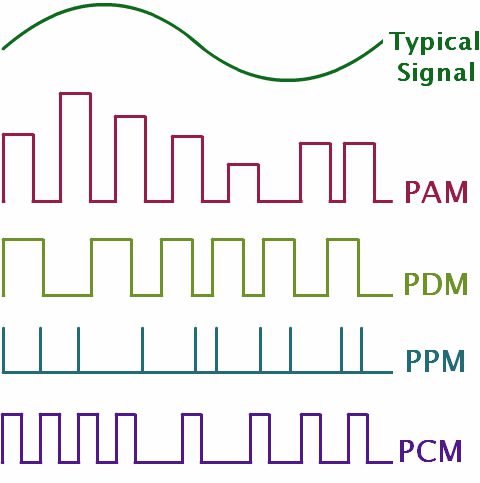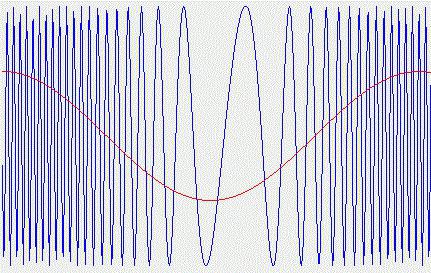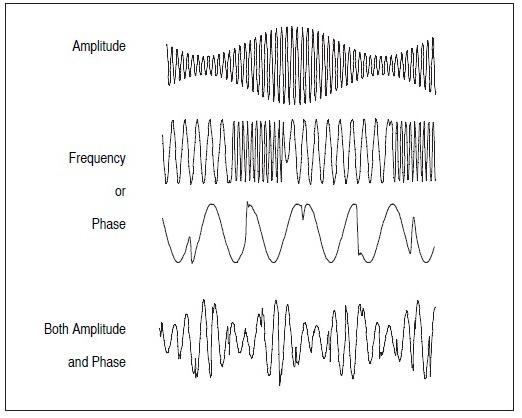Modulation is ... Pulse width modulation
Faced in daily life with newmany people try to find answers to their questions. It is for this to describe any phenomena. One is the notion of modulation. It will be discussed further on.
general description
Modulation is the process of changing one or the othera whole set of high-frequency oscillation parameters in accordance with the law of information low-frequency messages. The result is the transfer of the spectrum of the control signal to the high frequency region, since efficient broadcasting into space requires that all the transceivers operate at different frequencies without interrupting each other. Due to this process, information oscillations are placed on a carrier, a priori known. The control signal contains the transmitted information. High-frequency oscillation assumes the role of a carrier of information, due to which it acquires carrier status. The control signal contains the transmitted data. There are different types of modulation, which depend on which form of oscillation is used: rectangular, triangular or some other. With a discrete signal, it is customary to talk about manipulation. So, modulation is a process that involves oscillations, so it can be frequency, amplitude, phase, etc.

Varieties
Now you can consider what kinds of thisphenomena exist. In fact, modulation is a process in which a low-frequency wave is carried by a high-frequency wave. The most commonly used types are frequency, amplitude and phase. At frequency modulation there is a frequency change, at amplitude - amplitude, and at a phase - phase. There are also mixed species. Pulse modulation and modification relate to individual types. In this case, the parameters of the high-frequency oscillation change discretely.
Amplitude modulation
In systems with this type of change occurschange in the amplitude of the carrier wave with a high frequency by means of a modulating wave. When analyzing the frequencies at the output, not only the input frequencies are detected, but also their sum and difference. In this case, if the modulation is a complex wave, like, for example, speech signals consisting of a plurality of frequencies, then for the sum and the frequency difference, two bands, one below the carrier, and the other higher will be required. They are called lateral: upper and lower. The first is a copy of the original audio signal, shifted to a certain frequency. The lower band is a copy of the original signal that has been inverted, that is, the original upper frequencies are lower frequencies in the lower sideband.
The lower side is a mirrorDisplay of the upper side relative to the carrier frequency. A system using amplitude modulation, transmitting the carrier and both side, is called a two-band system. The carrier does not contain useful information, so it can be removed, but in any case the signal band will be twice the original one. The narrowing of the band is achieved due to the displacement of not only the carrier, but also one of the side, since they contain one information. This type is known as a single-band modulation with a suppressed carrier.

Demodulation
This process requires mixingThe modulated signal with a carrier of the same frequency that is emitted by the modulator. After this, the original signal is obtained as a separate frequency or frequency band, and then filtered from other signals. Sometimes the carrier generation for demodulation takes place on the spot, and it does not always coincide with the carrier frequency on the modulator itself. Due to the small difference between the frequencies there are discrepancies, which is typical for telephone circuits.

Pulse modulation
In this case, digitala modulating signal, i.e., it allows to encode more than one bit per baud by encoding a binary data signal into a signal with several levels. Binary signals are sometimes broken into pairs. For a pair of bits, you can use four combinations, with each pair being represented by one of four amplitude levels. Such an encoded signal is characterized in that the modulation rate in bauds is half the original data signal, so it can be used for amplitude modulation in the usual manner. Her application she found in the radio.
Frequency modulation
Systems with such a modulation assume thatthe carrier frequency will change accordingly with the shape of the modulating signal. This kind of surpasses the amplitude in terms of resistance to certain impacts on the telephone network, so it should be used at low speeds, where there is no need to attract a large frequency band.

Phase-amplitude modulation
To increase the number of bits per baud, you can combine phase and amplitude modulation.
As one of the modern methodsamplitude-phase modulation can be called one that is based on the transmission of multiple carriers. For example, in some application 48 carriers are used, separated by a band of 45 Hz. By combining amplitude and phase modulation for each carrier, up to 32 discrete states are allocated per each individual period of the baud, so that it is possible to carry 5 bits per baud. It turns out that all this set allows you to transfer 240 bits per baud. When operating at 9600 bps, the modulation rate only requires 40 baud. Such a low figure is quite tolerant of the amplitude and phase jumps inherent in the telephone network.
Pulse Code Modulation
This species is usually regarded assystems for broadcasting analog signals, for example, voice in digital form. This modulation technique is not used in modems. Here, the analog signal is sampled at a rate twice that of the highest frequency of the signal component in the analog form. When using such systems on telephone networks, gating occurs 8000 times per second. Each count is a voltage level encoded in a seven-bit code. In order to best represent spoken language, logarithmic coding is used. Seven bits together with the eight, talking about the presence of a signal, form an octet.
To restore the message, you need tomodulation and detection, that is, the reverse process. In this case, the signal is transformed by a nonlinear method. Nonlinear elements enrich the spectrum of the output signal with new components of the spectrum, and filters are used to isolate low-frequency components. Modulation and detection can be carried out using vacuum diodes, transistors, semiconductor diodes as nonlinear elements. Traditionally, point-like semiconductor diodes are used, since the input capacitance is much larger in plane planes.

Modern types
Digital modulation provides much moreInformation capacity and provides compatibility with a variety of digital data services. In addition, it increases the security of information, improves the quality of communication systems, and accelerates access to them.
There are a number of limitations with whichfaced developers of any system: the permissible power and width of the frequency band, a given noise level of communication systems. Every day, the number of users of communication systems is increasing, and the demand for them is increasing, which requires an increase in the radio resource. Digital modulation differs markedly from the analog one in that the carrier carries large amounts of information in it.

Difficulties of use
Before the developers of digital radio communication systemsthere is such a basic task - to find a compromise between the bandwidth of data translation and the complexity of the system in terms of technology. For this, it is appropriate to use different modulation methods to obtain the desired result. Radio communication can also be organized using the simplest transmitter and receiver circuits, but for this connection a frequency spectrum proportional to the number of users will be used. For more sophisticated receivers and transmitters, a smaller bandwidth is required to broadcast information in the same volume. For the transition to spectral-effective methods of transmission, it is necessary to complicate the equipment accordingly. This problem does not depend on the type of connection.
Alternative options
Pulse width modulation is characterized by,that its carrier signal is a sequence of pulses, while the pulse frequency is constant. The changes concern only the duration of each pulse according to the modulating signal.
Pulse width modulation differs fromfrequency-phase. The latter assumes the modulation of the signal in the form of a sinusoid. It is characterized by a constant amplitude and a variable frequency or phase. Pulse signals can also be modulated in frequency. The pulse duration can be fixed, and their frequency is in some average value, but their instantaneous value will vary depending on the modulating signals.

conclusions
You can use simple modes of modulation,This only one parameter will change accordingly with the modulating information. The combined modulation scheme, which is used in modern communication equipment, is when the amplitude and the carrier phases change simultaneously. In modern systems, several subcarriers can be used, for each of which modulation of a certain type is used. In this case we are talking about signal modulation schemes. This term is also used for complex multi-leveled species, when an additional description of characteristics is required for exhaustive information.
In modern communication systems are usedthe most effective types of modulation, thereby minimizing the bandwidth in order to free the frequency space for other types of signals. The quality of communication from this only wins, but the complexity of the equipment in this case is very high. Ultimately, the modulation frequency gives a result that is visible to the end user only in terms of usability of the hardware.
</ p>







